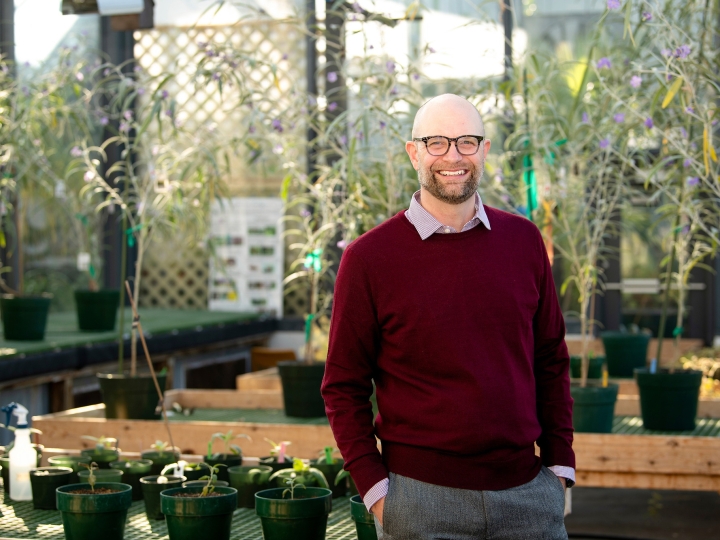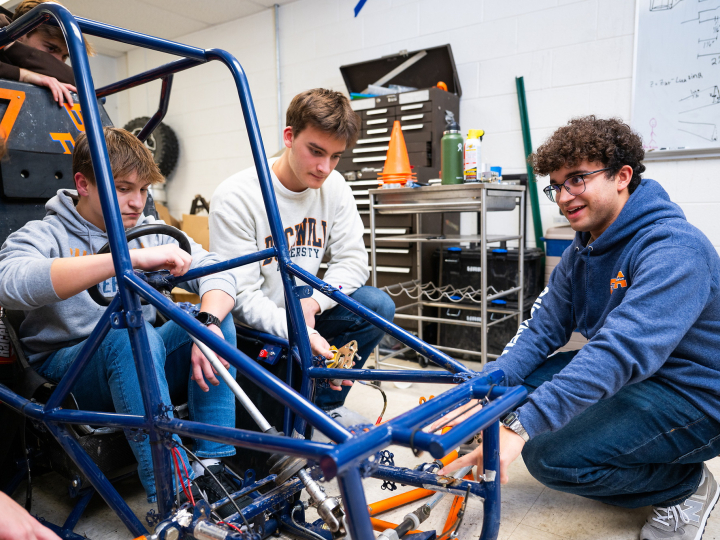
Of People & Places
January 12, 2017
Jennifer Smolko Vey '93, an alumna of Renaissance College, a residential arts and humanities college once housed in Smith Hall. Photo by Jennifer Bishop
Impact of Bucknell’s Residential Colleges program resonates through 3 decades
More than 30 years ago, Professor John Peeler, political science, and his colleagues set to work developing residential colleges on campus. As Bucknell celebrates three decades of themed living-learning communities, Peeler, a champion and architect of the program, reflects on how residential colleges have evolved into a signature aspect of Bucknell's liberal arts-based education.
"It's gratifying to have been part of improving the educational experience for a large number of students," says Peeler, now an emeritus professor. "It certainly is one of the things that I look back on as something I had a major impact on at Bucknell."
Peeler had long been interested in the concept, so when the movement to bring residential colleges to campus began, he was anxious to be part of it.
"Some of us had been working on the idea for several years in the late '70s and early '80s," he reflects. "We had administrators who liked the idea but always had reasons why we couldn't do it. It was about 1982 when Dean Robert Chambers of the College of Arts & Sciences said, ‘Let's do it.' It took a couple of years to get it worked out, but the key was having a senior administrator who was willing to give it a try."
Residential colleges weren't common in the early 1980s, but Bucknell also wasn't the first — Lehigh, Cornell, Yale and Princeton all served as examples of what could be possible. All shared a purpose: extending learning beyond the classroom to the residential setting, bringing faculty and students closer, and engaging students with common interests from classroom to dorm room. But there were so many ways to do it.
"Yale had a system in which students moved into residential colleges after the freshman year," Peeler says. "Princeton's focused exclusively on freshman year, and then moved into regular dormitories. Lehigh also had a system that went beyond the first year. We elected to start with the first year and do it well. Ultimately, we hoped to expand into the upperclass years."
Today, students choose from eight themed colleges: Arts College, Society & Technology College, Discovery College, Languages & Cultures College, Environmental College, Global College, Humanities College and Social Justice College. But in the beginning, there were just two: the humanities-oriented Renaissance College and the International College, emphasizing global affairs and social sciences. Although Bucknell didn't ask professors to live in student quarters, as Cambridge and Yale did, the planners crafted a distinctive two-tier leadership system to enhance student engagement. Today, as in the original model, faculty are Senior Fellows; Junior Fellows are sophomores living among first-year students to intentionally create bridges from classroom to residential hallways, thereby steering conversations and carrying academic discussion beyond the classroom.
"One of our key innovations that is still very central to the program is the two levels of leadership in each college," Peeler says. "We saw similar things at other schools but nothing quite as well developed as at Bucknell."
Then there was the question of required participation. Early on, planners considered whether participation should be mandatory, as it was at Yale.
"We concluded we should not require it," Peeler explains. "That's been better because if you require it of everyone, you'll have a much lower-intensity experience than if everyone is really into the program. I think we had hopes in the beginning that this would be so attractive to incoming students that most would want to be part of it."
Those closest to the program today see this early decision as one of the program's greatest strengths.
"The main reason our residential college program is strong is that students opt into it rather than being compelled to participate," says academic co-coordinator Professor Roger Rothman, art & art history. "Another strength is that the topics shaping the different residential colleges are faculty driven. We don't administer this program by saying we need five professors to teach this topic — it's based on faculty interests."
For the first 25 years of Bucknell's program, enrollment was steady with about 250 first-year students electing to live in residential colleges out of first-year classes of usually just over 900 students, says Program Coordinator Kelly Finley.
"That's interesting because we started out with two themes and, over the years, added six more and still attracted the same number of students," Finley points out. "Then in 2013, we added the Discovery College, which intrigued our science folks and tapped into a new area of interest."
She says adding Discovery College, plus the University's newly instituted summer academic counseling program that formally introduces incoming students to residential colleges, has increased overall enrollment to 350 since 2013. And now, as Peeler had hoped, expansion into upper classes is taking root. Bucknell already offers students Residential College Alumni Housing, a residential continuation of themed living communities. Rothman said about half the residential college students elect alumni housing as sophomores. An academic component is also in development.
"We're always experimenting," Rothman says. "We're now in the third year of piloting a sophomore version of our first-year programming. It's on a smaller scale, but we took the idea of the evening common hour and turned it into a mini-course in which students develop a yearlong project related to the theme of their college. They construct the assignments themselves, and they meet with a professor weekly, often over dinner."
Finley says close to 30 students each year participate in the sophomore pilot classes, which are still evolving.
"We're trying to figure out if we want to expand it to all eight themes, or move away from being theme specific, or if there's another model out there that will work," she says. "We're looking for the right mix of experiences to offer students after their first year."
It's perhaps ironic that in the age of cyber communications and social media, a model first identified in 1264 at the University of Oxford's Merton College is still relevant. After a brief flourishing in this country's earliest Colonial institutions, the residential-learning model was superseded by the German model of free electives without the obligation of chapel attendance, and dorm and community rules. Early in the 20th century, Princeton President Woodrow Wilson led the charge to revive residential colleges to "awaken the whole man" in hopes Princeton would be, "not a place where a lad finds a profession, but a place where he finds himself."
Once again universities grouped students in living arrangements where they could pray, eat, discuss and debate — and with the more practical hope the arrangement would keep them out of trouble.
Even as late as the 1960s, universities served as parental surrogates for students. But a change was afoot.
"There was a big shift in higher education away from ‘loco parentis' to one that acknowledged that students are adults who can vote and go to war," Finley says. "They don't need a parent so much — they need to learn what it means to be adults. So schools moved away from that approach and toward student development."
On Finley's office shelf sits a thick, blue three-ring binder that provides a snapshot of the University's approach to bridging the gap between the classroom and student residential experiences — a sort of blueprint for Bucknell's residential colleges. Memos typed on onion-skin paper show the attention to detail paid by Peeler and his colleagues as they designed Bucknell's program from the 1970s into the early '80s.
A sleeve holds dated pamphlets from other schools' programs, including Northwestern University, Bryn Mawr College and the University of Illinois. Professor John Murphy, English, an early proponent of the program, asked colleagues to "Xerox" plans for meetings. Perhaps a measure of the undertaking's mood is revealed in Murphy's memo sign-offs, which swung from "Encouragingly yours," to "Insistently yours," as deadlines neared.
A 1986 memo explains that the International College would feature a short-wave radio, a piano and sound system. Several other memos questioned whether the first year's schedule (which included a screening of the Harrison Ford film Witness, a flea-market expedition and treasure hunt) was too ambitious; another suggested "fireside chats" might have a better chance of long-term popularity if the issue of alcohol consumption was discreetly introduced later rather than sooner. On the challenge of keeping students engaged, a handwritten letter from a Bryn Mawr residential college administrator cautioned that while "fireside chats" are a great idea, their location matters. She described witnessing "large (and I do mean large) crowds of people in TV lounges" watching Cheers on Thursday nights rather than conversing. "I'd hate to compete with a television set," she concluded.
Rather than visiting local flea markets, today's students travel to attend Broadway shows and visit the National September 11 Memorial & Museum in New York City, and to Washington, D.C.'s National Gallery of Art. They participate in Stop the Hate marches and service projects in Lewisburg. And the difficult leap from high school to college is reduced to a step.
"I struggled with the adjustment and the heightened expectations of college," says Megan Grossman '19, a chemical engineering major who joined the Society & Technology College. "The college really helped me integrate into an academic community that shared my interests. For that, I'll always be thankful. It made Bucknell a home away from home for me."
Grossman was so sold on her first-year experience in the Society & Technology College, she became a sophomore resident fellow in the college's alumni housing.
"Joining a residential college was one of the best decisions I made my first year at Bucknell. I want to make it a positive experience for other first years," she says. "I like putting effort into something I believe in, and I truly believe in the residential colleges. It's really rewarding for me."
For Peeler, therein lies the reward, 30 years later and counting.
"It illustrates that we shouldn't be afraid to try something new," he says. "You can work on an idea and develop it and tweak it and, ultimately, there's a good chance it will persist and have a positive impact for many years."
Learn more about the 30-yr Anniversary at bucknell.edu/30Years.

